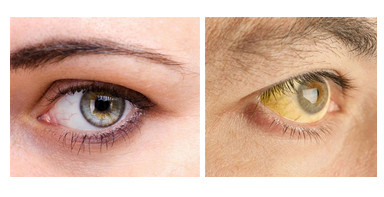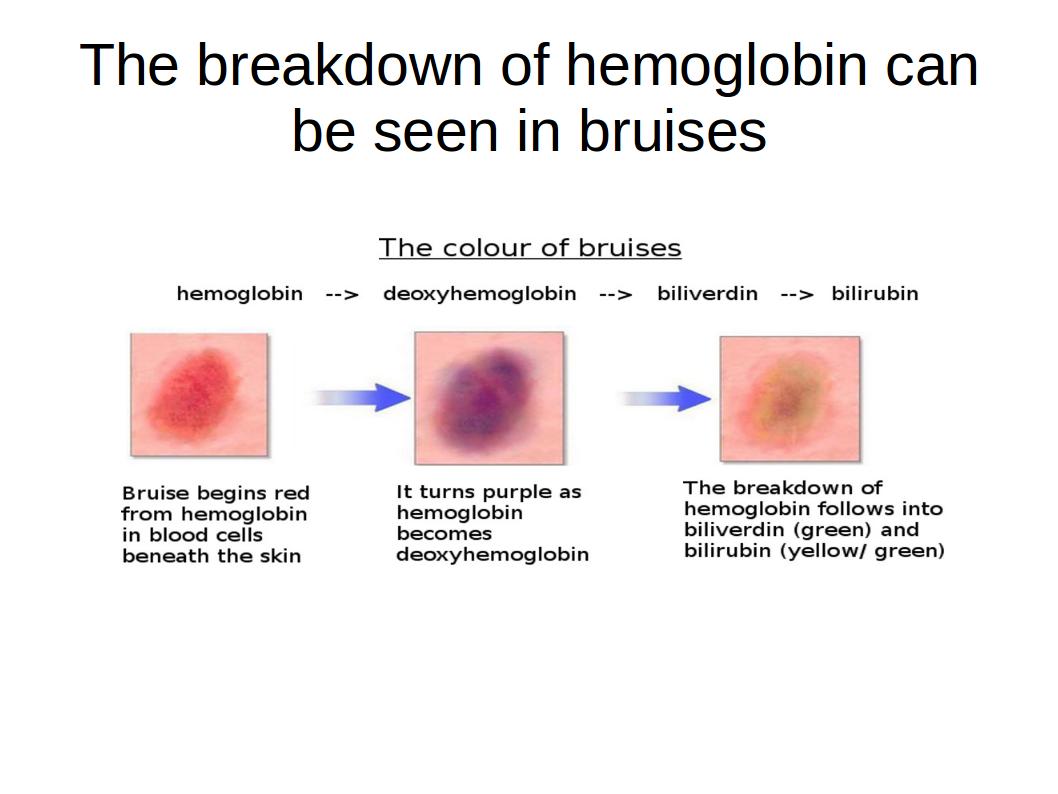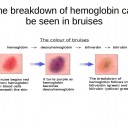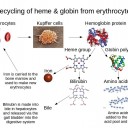Jaundice & liver function
 Jaundice is a yellow decolouration of the skin and the whites of the eyes, caused by a build up of bile pigment (bilirubin). This activity puts student in the role of a junior doctor, examining a patient with Jaundice, and exploring the causes and consequences. A second activity reviews the recycling of red blood cells (erythrocytes) in the liver and also how this process causes a surprising range of colours in bruises as they heal.
Jaundice is a yellow decolouration of the skin and the whites of the eyes, caused by a build up of bile pigment (bilirubin). This activity puts student in the role of a junior doctor, examining a patient with Jaundice, and exploring the causes and consequences. A second activity reviews the recycling of red blood cells (erythrocytes) in the liver and also how this process causes a surprising range of colours in bruises as they heal.
Lesson Description
Guiding Questions
Why would each of these liver problems could cause bilirubin to accumulate in the liver or in the blood?
- The bile duct is blocked by a gall stone.
- Hepatocytes are damaged by a viral liver infection like 'hepatitis'.
- The sinusoids are blocked by uncontrolled cell growth in a liver cancer.
- There are too many erythrocytes in the blood for Kupffer cells to engulf them all.
Activity 1 - Doctor doctor
A patient comes to your surgery complaining of feeling very tired. When you examine her eyes the white area of each eye is yellow. You think this might be Jaundice, but can't remember what you learned at medical school.
Watch this introduction to remind you: ![]() Introduction to Jaundice
Introduction to Jaundice
Read this concise information pages:
Jaundice:
- What are the symptoms of Jaundice
...................................................................................................................................................
- State which chemical from the liver causes the yellow colouring.
...................................................................................................................................................
- Outline the causes of jaundice.
...................................................................................................................................................
Underlying causes of jaundice
In adults, the jaundice itself usually doesn't cause health problems,
apart from some itching, but the underlying causes can be more serious.
Use your knowledge of liver structure to explain why each of the following underlying problems may cause jaundice, with the symptoms described:
- With hepatitis, an infection of the liver, damaging hepatocytes, the person may have a fever as well a jaundice.
...................................................................................................................................................
- With blockage of the bile duct, there may also be symptoms such as upper abdominal pain and pale stools (faeces).
...................................................................................................................................................
Activity 2 - Recycling of erythrocytes & Kupffer cells
Read the following slides which explain how the liver recycles the hemoglobin from red blood cells.
Make summary notes using the ![]() Recycling erythrocytes student sheet.
Recycling erythrocytes student sheet.
Activity 3 - Reading about Biology
This short article covers some interesting examples of bilirubin in nature.
"Some lizards have green blood that should kill them
– and scientists can’t work out why"
Senior Lecturer in Ecology and Evolutionary Genetics, Bangor University
Read the whole article here (published with a creative commons licence)
If you were to see certain New Guinea skinks lose their tails, you’d notice that their blood isn’t the usual red colour we’re used to but rather a virulent shade of green. What’s even more bizarre is that the substance that’s responsible for the green colour of the lizards’ blood (and bones, tongues, muscles and mucous membranes) would be toxic in other animals if they carried it in such large amounts.
Exactly why these skinks are filled with this toxic substance and why it doesn’t kill them is something of a mystery. But new research published in Science Advances makes an important step towards answering these questions.
Whereas the red colour of most animals’ blood comes from the oxygen-carrying pigment in red blood cells called haemoglobin, the green colour in the New Guinea skink blood comes from a kind of bile pigment called biliverdin. It is formed as red blood cells break down and is held in the plasma, the liquid that makes up most of the blood. In large quantities, it masks the red colour of haemoglobin completely.
Teacher's notes
The first activity is a great review of liver structure because an understzanding of the structure is required to be able to answer the questions. The video is only short, but contains very clear information, as do the web links.
The second activity covers a complex metabolic process, the breakdown (catalysis) of hemoglobin. This process is mentioned in the IB guide but only in simplel details, which have been included here. The process of forming bile and the transfer of iron to the bone marrow has not been included, as it is not mentioned specifically in the guide.
One interesting feature of the breakdown of hemoglobin and the products is the way it colours some everyday things, like bruises and urine or faeces. The link below gives more detail, and the slide in activity two gives a nice summary or bruise colours.
The Chemistry of bodily fluid colours is a really nice infographic about colours of hemoglobin, bilirubin and how these pigments cause the varied colours of bruises, the yellow in urine and the brown colour in faeces.

 IB Docs (2) Team
IB Docs (2) Team




